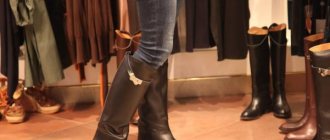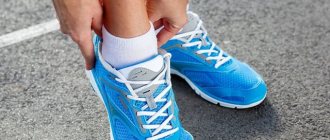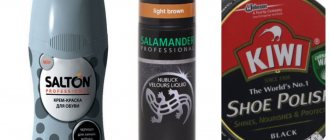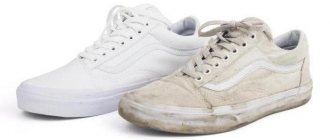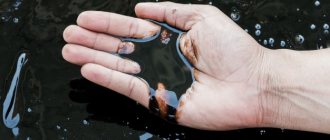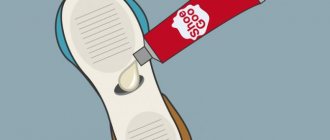Sneakers are the most popular footwear today, providing comfort and a stylish appearance. But no matter how high-quality they are, sooner or later everyone “gets sick” and requires “treatment.” Defects can occur externally or internally. If the damage is not too serious, it will be much cheaper to repair it yourself than to buy a new pair.
If you rub your heel in sneakers
Chafing heels are a fairly common symptom of recently purchased shoes. In order not to carry around a pack of adhesive plasters to cover abrasions, you need to solve the problem as soon as the problem arises. To do this, you can use the following tips:
- Special silicone stickers on the heels of shoes prevent the appearance of calluses;
- To soften hard heels, use a hammer to lightly tap the back of leather shoes from the inside;
- Place a towel soaked in warm water in the shoes and leave for 20-30 minutes. After this, apply pharmaceutical glycerin to the water-softened backdrops and leave until the morning. If this procedure does not help the first time, it is recommended to repeat it;
- If shoes have been left for a long time without proper care, the leather can dry out and rub the heels. To cope with this problem, you need to lubricate the back with baby cream, fat or soap and leave it overnight;
- If your sneakers are rubbing at the back due to the seam running along the heel, you should contact a shoe repair shop. The master will install a patch made of soft material in this place. In addition, the workshop offers a service for stretching shoes to length, which will also help achieve wearing comfort.
How to glue the sole of a shoe with your own hands: cold and hot method
Now that a high-quality adhesive composition has been selected, it’s time to start repairing shoes yourself. In practice, there are two most popular and effective ways to properly glue shoes.
- Cold technique . It is quite easy to use and does not require any special skills from the master. If the sole bursts in half, then just clean the joint, apply adhesive to it and firmly press the two halves. It is important to ensure that there are no voids left in the seam. After the parts are securely connected, the product is placed under pressure and left for at least 10 hours.
- Hot technique . How to glue parts this way? The manufacturer advised using glue to repair shoes using this method only in cases where the sole is very hard. You need to apply the adhesive to the top of the shoe and leave for half an hour. Afterwards, the sole is heated using a burner or hair dryer, pressed to the top and held for at least half a minute. You can put on shoes after such gluing only after two days.
Both of these methods make it possible to ensure high bonding strength of parts. The seam resists moisture and frost.
Sports shoe repair: sealing the soles of sneakers
Most often, sports shoes, namely sneakers, tear during wear. Are you wondering how to glue the sole to sneakers for which, at first glance, nothing will help? Repairing the soles of sneakers with your own hands is not a difficult task, but you need to do everything correctly. Due to their specific nature, such shoes have a soft bottom part, so holes easily appear on them.
To seal worn shoes, you should thoroughly clean the hole from dirt and debris. Then treat with a degreasing agent, and only after that pick up the glue. If the hole is too big, we first glue a fiberglass mesh. Next, you need to fill the hole with glue, and then secure it with construction tape so that the surface remains perfectly flat.
The specifics of how to seal the soles of sneakers are simple and clear. To reliably glue sneakers, you can use domestically produced epoxy resin. If the sole of your sneakers often peels off in the toe area, then before gluing, the area should be well sanded and degreased. Then cut out the patch, process it as well and apply glue to both surfaces. Press the sole onto the top of the shoe and hold for 15 seconds, then place under a press for 24 hours.
What shoe glue to use to fix a hole in a sneaker?
What kind of adhesive should be used to seal the sneakers yourself at home? Fixing a hole in the sole is not difficult. But as for the glue, it must be strong, elastic and abrasion-resistant. For these purposes, we recommend using Seam Grip from an American manufacturer. It has ideal seam elasticity, so it can be used to securely seal rubber. In addition, the following adhesives are suitable:
- Polyurethane adhesive Desmokol;
- EVA;
- Secondary glue Super Moment for shoes;
- Kenda Farben SAR 306.
Professionals recommend using Desmokol at home; it is easy to use for DIY shoe repair. To do the job correctly, we recommend watching a video on how to glue a hole in a shoe:
How to repair winter boots at home?
Most often, the sole of winter boots resembles a honeycomb, and voids form in them over time. It is difficult to seal boots with such problems, but it is possible. Empty honeycombs are filled with micropore scraps or another type of rubber, but only porous. To carry out this work, you will have to bend the insole, and then fill everything with sealant.
How to repair sneakers: restoration of the heel
Over time, the following changes occur with the backdrop: the material tears, the inner lining comes out, and discomfort occurs due to deformations. To repair a torn backdrop, you must first cut off the frayed edges at the lining. Then a piece of thin soft leather is selected. A blank shaped like a small horseshoe is cut out of it. This part is treated with shoe glue (the edges are coated especially carefully).
The most important stage of the work is to carefully cover the “wounded” area of the back with a patch, and then straighten it with your fingers so that there are no wrinkles. Then place an object of suitable size inside to press the material tightly for several hours to securely fix the patch.
Take off and put on sneakers only unlaced
Because of the rush, we don't untie our sneakers. At such moments, we overcome the resistance of the backdrop to take off our shoes. Think about it: the heel, which is designed to support our foot, resists our pressure every time. We win, but the heel of the sneaker loses and wears out faster.
On many sneakers, the lacing even goes along the instep of the foot. This helps avoid ankle injuries. In such cases, it is necessary not only to untie the laces, but also to loosen the lacing.
Moleskin
You can take the additional steps above by using a self-adhesive material called Moleskin. It's designed to put you on your feet, but you can instead adjust it to your shoes for a more secure fit.
You may have to replace it from time to time, but it's inexpensive and has the added bonus of adding enough padding to make them more comfortable.
Tread rehabilitation
The vulnerable part is the protectors, especially their heel part. For example, due to active use they may burst. If you need to repair these elements, you will need a piece of hard rubber (the sole of some unnecessary shoes may come in handy). You will also need coarse sandpaper, a sharp knife, and shoe glue. The algorithm of actions will be as follows:
- A rubber patch is cut out to match the shape of the old tread.
- The patch is given a wedge-shaped shape using a knife and sandpaper.
- To make the surfaces to be glued rough, they are treated with sandpaper. Then they are wiped with solvent and left to dry.
- The patch is covered with two layers of glue. The area where the new protector will be placed is processed in the same way. The first layer dries in 20 minutes, and the second in about 5 hours.
- After the adhesive composition has dried, the surfaces are heated over the stove until a characteristic odor appears. Then they are pressed tightly against each other and held until they cool down and are firmly fixed.
Can I wear sneakers with repaired treads right away? If there is an urgent need, then this is permitted. However, it is better to wait a day before using it - this will make the design as reliable as possible.
Read also: How to create volume on long hair
Sole
The quality and condition of the sole affects the comfort when wearing sports shoes. With prolonged use, the sole of the sneakers wears out and becomes deformed. Stepping on stones and unpaved surfaces risks damaging the sole, causing holes to form on it.
How to seal a hole
Any holes in the sole can be repaired in different ways, depending on the base material of the sneakers and the extent of the damage. Most often, epoxy glue is used to eliminate holes, which is relatively affordable and easy to use. Holes on the sole are sealed as follows:
- all edges of the hole are well cleaned and treated with a solvent to degrease;
- when the area next to the defect is completely dry, apply the diluted adhesive composition;
- if the hole in the sole of the sneaker is too large, a fiberglass mesh is placed in it to fill the void;
- when the glue dries, cover the damaged area from the outside with masking tape to level the sole;
- The sneakers are left in a well-ventilated area to dry completely.
How to increase worn out
If the soft sole of the sneakers has worn down slightly, it can be increased to its original thickness. For this purpose, you will need to purchase microporous rubber. A blank is cut out of the material in the shape of the worn-out element, the surface is cleaned with sandpaper and glued to the shoes.
It is better to use a special kind of shoe glue as glue to ensure reliable adhesion.
Replacement
A sole with a lot of damage is easier to replace with a new one. This will significantly reduce the time spent on repairing each damaged area. The replacement sole, as well as for extension, is cut out of microporous rubber. The sneaker is applied to the cardboard and the outline is outlined, and then it is transferred to the prepared material and the blank is cut out.
How to repair a heel
To repair heels on sneakers, you need to get rid of the old tread, tearing it off the sole, cutting it in places where it is impossible to separate the element manually. To simplify the task, you can treat problem areas with a solvent.
After removing the tread, the contour of the sole is transferred to thick paper or cardboard and the erased edges are completed. Having drawn the outline, the pattern is cut out of paper and used to create a new blank. You can make the sole from a rubber mat, which is sold in hardware stores. It is impractical to partially restore the sole, so if the heel of the sneakers is damaged, the base is completely changed.
When gluing the sole to the main part of a sports shoe, you need to thoroughly clean the surface. Otherwise, the gluing procedure does not differ from the standard one.
How to repair the heel of a sneaker
Damage to the back of sneakers manifests itself in different ways: the fabric tears, the inner lining comes out, and discomfort appears in the heel.
When repairing shoes at home, you can take the following steps:
Important nuances
When planning repairs, you should take into account that different sports models differ in their materials. Further actions will largely depend on this.
In general, the following areas are susceptible to damage:
- sock;
- backdrop;
- heel;
- tread;
- sole.
! A pressing problem is cracks in the folds (most often leather shoes suffer).
Why does this happen?
- The most common option is poor quality shoes. If the materials from which the shoes were made are of very low quality, then the shoes will quickly wear out at all places where they are folded.
- Health. About 80% of the population have various types of foot deformities to one degree or another. In accordance with the characteristics of gait, overload zones appear in the areas of “shifts” of the pressure curve, and at a certain age, corns form. The skin of the outer edge of the heel, the forefoot, and the inner edge of the big toe are especially affected. This is where excessive shoe wear occurs. Most often, excessive shoe wear causes flat feet. With this disease, a person simply cannot place his foot correctly and evenly, as a result of which the shoes quickly lose their shape and wear out. The same goes for the heel. If the shoe itself is severely deformed, then the heel begins to wear out.
- Influence of type of activity. Many dancers who wear professional dance shoes complain that even expensive ballet shoes wear out quickly. The reason here is that dancers have too much mobility in their feet. Even when walking normally, they arch their foot, causing the heel to rub. But most often car drivers face this problem. When you constantly press the gas brake pedal, the heel rubs against the plastic. To avoid this, you just need to drive the car more carefully and watch where your foot is positioned on the pedals. If you can’t do this, then special “overlays” for shoes are sold for such cases. They are easy to put on any shoe. Made from a variety of materials and colors, this type of “shoe” for your shoes will protect them and extend their lifespan.
Elimination of cracks
Is it possible to repair the cracks that traditionally disfigure the folds that accompany the junction of the top and the foot (this phenomenon is inevitable over time for leather models)? It turns out that in order to repair these defects, you need to carefully trim the sole, bend it, and then seal the cracks with pieces of suede with the nap facing outward. In addition, it is permissible to eliminate defects with a leather patch.
As for cracks that make sneakers less presentable, some measures will help initially prevent or reduce their formation:
- keep your shoes clean, as dirt causes cracks to form;
- during storage (for example, in winter), fill the sneakers with paper, this will allow their body to flatten; it is also good to use special mold holders, spacers, and pads.
- wear styles that fit only (because if they are too big, cracks appear faster);
- Avoid excessive bending of the feet and prolonged pressure when walking.
Top repair
The upper part, especially the toe, is most subject to wear due to increased load: worn areas appear. In order to repair this area as efficiently as possible, you need to take into account the material of manufacture. So, if the materials used are leather (natural or artificial), suede, then over time the upper part becomes riddled with cracks, or the material simply wears off. The solution to the problem is to apply a patch: it can be sewn or glued, after first removing the damaged part.
Of course, such manipulation will require painstaking work, as well as a certain amount of skill and experience, so it is better to help ensure that your favorite sneakers retain their original appearance for as long as possible. For example, it is advisable to regularly treat natural leather with a special cream, and clean suede with a stiff, dry brush, lifting the pile. To clean the top of dirt, use a damp cloth instead of rinsing under running water.
Often sneakers have a combination upper, when leather or suede is combined with synthetic fabric with a foam padding. Another common option is purely textile, or rag, sneakers. Sometimes the area of the mesh where the material comes into contact with the fingers is protected by a rubber pad, this is especially true for running models. A patch will help to eliminate minor damage to rags. When the fabric has large defects (holes, cuts), the mesh is rehabilitated as follows: the seams are ripped up, the necessary element is cut out from durable nylon, and a patch is sewn on. It is important that it should be slightly larger in size than the damaged area of the mesh in order to completely hide the defect and reduce the likelihood of another rupture.



